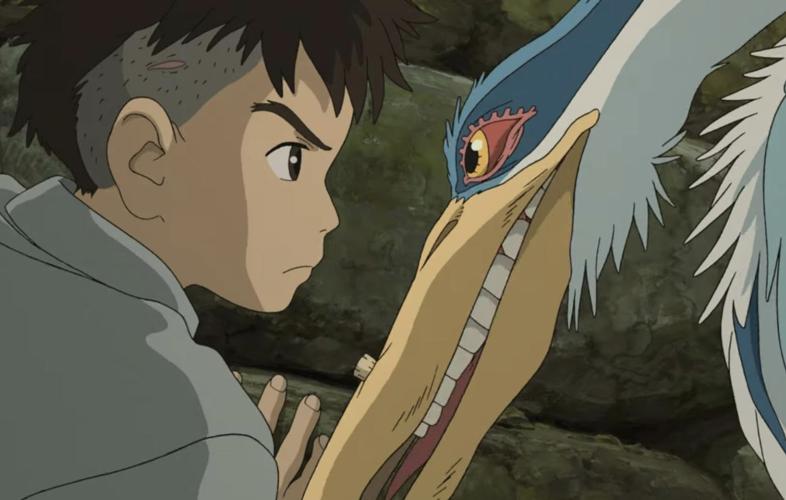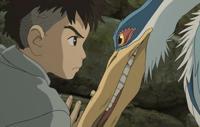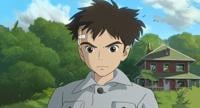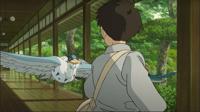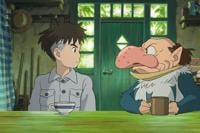It might be a bright-colored, animated film, but it's one that isn't for children or young people under 13. Even though there are some eye-popping drawings and beautifully made, 2D work with cute characters and silly scenarios that could delight or entertain a child, the story is mostly a slow and deliberate one that would only enthrall the most patient of prepubescent humans. The opening of this film is in fact a commentary on the Pacific War, that of the death and destruction wrought in the 1930's, which is definitely a way of reeling viewers into it. However, what follows is a quiet, almost meditative section of a grieving boy having to adjust to the reality of a new stepmother and a pending sibling. The film seems intent on dealing with the boy getting over a familial loss, as well as a changing familial landscape.
Writer-director Hayao Miyazaki (Howl's Moving Castle and Spirited Away) does so by having his protagonist under a plot akin to Alice in Wonderland (1951). Instead of a white rabbit that leads the unlikely child into a fantastical world, here Miyazaki gives us a grey heron. Unlike Walt Disney, Miyazaki has no strong interest in making his talking animals adorable or cherubic. Miyazaki, for lack of a better word, isn't afraid to make his characters ugly. The grey heron in question looks realistic at first but over time it's revealed to be quite an ugly creation that might be deformed, emerging as what could be described as a troll-like man in a bird costume. His appearance isn't meant to be aesthetically pleasing. It might also be a bit horrific, as Miyazaki isn't above animating blood gushing or dripping, as well as animal guts pouring out.

Older audiences might certainly appreciate the adult nature of the animation here to be ugly and blood-soaked. The slow and quiet pacing might also appeal to those who are fed up, if not tired of the kind of animation from Pixar, Illumination or the likes of Phil Lord and Christopher Miller, which is so frenetic and pitched at a break-neck speed. Miyazaki is a master in giving us animation that advances at a snail's pace or at a speed that is arguably gentle or even soft. The way that Miyazaki or indeed Studio Ghibli's films move allow for more time to focus on characters. This one is no different. However, I'm not sure the film succeeds in getting us to care about the characters all that much.
The protagonist is a young teenage boy named Mahito Maki. After his mother's death, Mahito's father moves him out of the city of Tokyo and into the country side. Presumably, they go to live in the rural home town of his mother. It's never commented upon, but, Mahito's father remarries his wife's sister, Natsuko and impregnates her. This means that Mahito's new sibling will also be his new cousin. This might seem odd, but a similar thing happened in Martin Scorsese's Killers of the Flower Moon (2023), which is also set in the early 20th century, prior to World War II, so maybe men marrying their sisters-in-law weren't as taboo back then as it might be now.

Things change when a flying creature that is and that's called the "Grey Heron" appears at the house and starts basically stalking Mahito. It gets bizarre when the Grey Heron even begins speaking and attempts to lure Mahito into a nearby tower that looks run down and sealed off. The Grey Heron is able to get Mahito to go into the tower because Natsuko disappears and it's presumed that the Grey Heron kidnapped her and brought her to that tower. The Grey Heron denies it. Yet, the film never explains what happened to her and why Natsuko disappeared.
What follows is akin to Mamoru Hosoda's Mirai (2018), which was nominated for Best Animated Feature at the 91st Academy Awards. Hosoda's film was about a child confronting his parents on an even level and understanding his parents' history. Mirai was essentially a time-travel narrative. Hosoda's time-travel device was a garden, whereas Miyazaki's device is the aforementioned nearby tower. Except, there is some confusion because it seems as though his device isn't time-travel but something akin to all the multiverse stuff we've seen in recent Hollywood, comic book flicks. There's even a door element that felt ripped from Shazam! (2019). The idea that the real device is time-travel doesn't come until toward the end as a bit of a surprise.

Because of the surprise, it doesn't allow Miyazaki to develop this aspect. The aspect of a child confronting his parents gets lost as a result. Ostensibly, the story of Mahito going on a quest to find Natsuko gets rather lost as well. There's a large chunk of the middle of this film where one forgets what Mahito is even doing on a quest with a diversion with a character named Kiriko that felt more like padding than vital storytelling. There's also this late in the narrative plot line, involving a character called the Parakeet King, that felt like it came out of nowhere. It also didn't have time to be fully developed either.
PG-13 for some violent content, bloody images and smoking.
Running Time: 2 hrs. and 4 mins.
In theaters.


